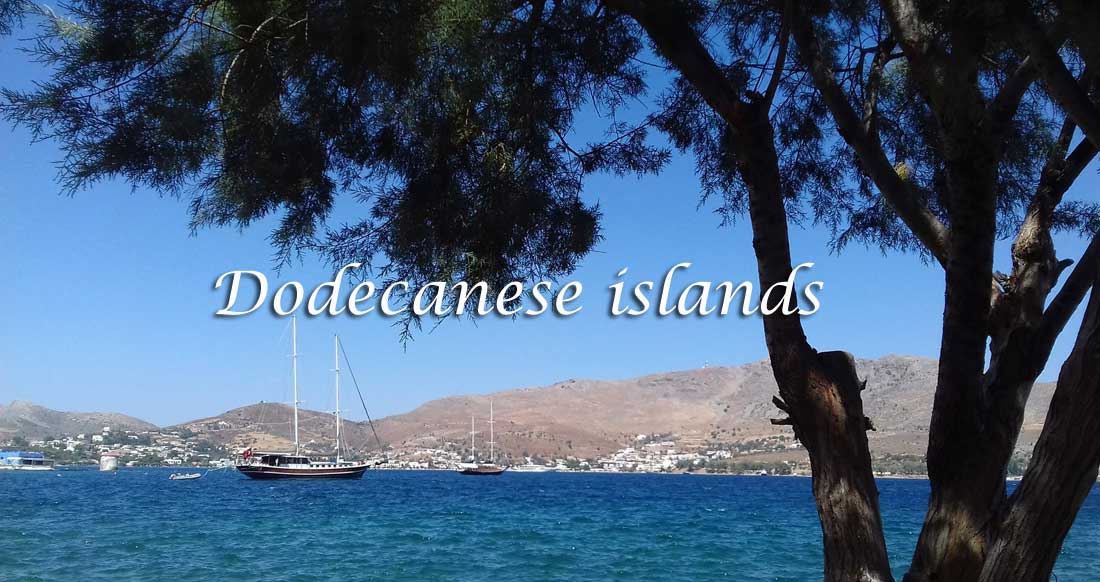Information about the Dodecanese islands Greece
The Dodecanese is a group of islands in the South East Aegean in Greece, defined to the North by the island of Samos, Nothwest by the Cyclades, West by the Cretan Sea and East by Asia Minor.
The Dodecanese consists of 18 large islands, many smaller and many rocky islets.
The largest islands of the Dodecanese are: Rhodes, Kos, Karpathos, Kalymnos, Astypalea, Kasos, Tilos, Symi, Leros, Nisyros, Patmos, Kastellorizo, Halki, Lipsi, Agathonisi and Arkioi.
The Prefecture of Dodecanese has an area of 2,705 sq. Km. And a population of 162,439 inhabitants. The capital is Rhodes. Administratively it is divided into four provinces: Kalymnos with its capital Kalymnos, Karpathos with its capital Karpathos, Kos with its capital Kos and Rhodes with its capital Rhodes.
Due to their geographical location, they were subjected to destructive raids by the Persians, the Saracens, the Venetians, the Genoese, the Crusaders and the Turks (Seljuks and Ottomans). From 1309 they came under the rule of the Knights of St. John and remained under their rule until 1522, when they were occupied by the Ottoman Turks.
With the beginning of the Greek liberation struggle of 1821, the Dodecanese revolted, but in 1830 they returned together with Samos to the Ottoman Empire, in exchange for Evia, which was incorporated into the free Greek state.
During your visit to the islands of the Dodecanese, in addition to a wonderful vacation, you will have the opportunity to admire the unique scenery of nature that successfully combines the rich and colorful vegetation with the relaxing blue of the sky and the sea.
The capital of the Dodecanese is Rhodes, which offers the visitor relaxation and tranquility but at the same time an intense cosmopolitan life for those who want it.
The island of Kos is known not only for its fantastic sandy beaches but also as the birthplace of Hippocrates, the father of medicine.
Another island worth getting to know and exploring is Kalymnos, rich in history and many attractions.
The Dodecanese are here and waiting for you. They are ready to embrace you and offer you unique opportunities for holidays that will be truly unforgettable.
Geography

There are no rivers in the Dodecanese, although they have plenty of water in torrents and streams. Thermal Springs: Four of the islands have thermal springs. In Rhodes there is the spring of Kallithea, a cold source of sodium chloride with drinking water. In Kos there are the chlorodium hot springs of Agios Fokas and Rhodes. In Nisyros is the source of Mandraki, hot alipine and in Kalymnos the homogeneous alipine of Kalymnos.
The Dodecanese are volcanic and therefore have significant amounts of mineral wealth. In Rhodes there is gypsum, chromite and lignite, in Kos copper, iron, lead and lignite, in Nisyros sulfur and in Karpathos and Kasos gypsum.
Economy
Just as the islands are scattered and small, they do not present economic unity. Everyone has their own economy. In the larger ones the land is cultivated intensively. Their vegetable products are famous. A large part of the inhabitants of the islands are also involved in sponge fishing, which takes place both on their shores and on the coasts of North Africa. There are also small agricultural processing industries and tanneries. Tourism also plays a serious role in the economy of the prefecture. The islands have been properly utilized and are one of the best resorts in the Mediterranean.
History
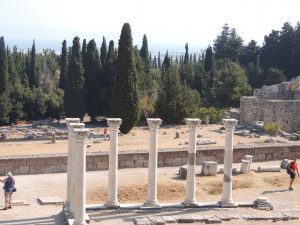
The Dodecanese have been inhabited since the Neolithic Age. They were inhabited by Mycenaeans, Carians and Phoenicians and developed close relations with Crete during its heyday. In historical times they developed shipping and trade and flourished. They even established colonies in Lower Italy, Sicily and the coasts of Central Asia. In the 5th BC. ai. were conquered by the Persians and forced to fight against the Greeks. They were liberated at the end of the Persian Wars and became members of the Athenian Alliance.
In Byzantine times they were the Theme of the Islands. Due to their geographical location, they experienced many catastrophic raids. In the 14th ceentury AD. were granted to the Knights of St. John. Until the 15th century, when they were enslaved by the Turks.
The Dodecanese experienced economic and spiritual prosperity. During the Turkish occupation, they gained autonomy by paying only an annual tax. They were liberated from the Turks in 1912, when they were occupied by the Italians. They united with Greece after the end of World War II, with a treaty signed by Greece and Italy on February 10, 1947 and which was implemented in 1948.
On February 10, 1947, the Peace Treaty with Italy was signed in Paris, according to which the Dodecanese were ceded to Greece, while Italy was obliged to pay $ 105 million to Greece. At the insistence of the Soviet side, the text stated that the islands would remain demilitarized, a provision that Turkey would abusively invoke after 1974.
From the Turkish interpretation of the text of the Greek-Italian Treaty of 1947, in conjunction with the 1932 Italian-Turkish agreements The issue of the “gray zones” raised by Ankara after the Imia Crisis in 1996 will also arise.
The handover ceremony of the Dodecanese to Greece by the British authorities took place on March 31, 1947 in Rhodes in a festive atmosphere. The first commander of the Dodecanese was taken over by Rear Admiral Pericles Ioannidis, with political advisor to the university and judge Michael Stasinopoulos, later President of the Hellenic Republic. The official ceremony of integration took place on March 7, 1948 and in 1955 the Dodecanese became a Greek prefecture with Rhodes as its capital.
Dodecanese Beaches
The Dodecanese archipelago in the southeastern Aegean Sea is renowned for its breathtaking beaches, each offering a unique blend of natural beauty, crystal-clear waters, and cultural allure. These islands, steeped in history and myth, are dotted with beaches that cater to every type of traveler, from secluded coves perfect for relaxation to lively shores bustling with activities.
One of the most stunning beaches in the Dodecanese is Lindos Beach on Rhodes. This crescent-shaped bay, framed by rugged cliffs and crowned with the ancient Acropolis of Lindos, provides a perfect backdrop for a day of sun and sea. The soft, golden sand and shallow, turquoise waters make it ideal for families, while the nearby town of Lindos offers charming tavernas and shops, blending a beach day with cultural exploration.
Further south on Rhodes, Prasonisi Beach stands out as a unique geographical marvel. This sandy isthmus connects the mainland to a small island, creating two contrasting coastlines: one with calm waters and the other with rolling waves. This dual nature makes Prasonisi a paradise for windsurfing and kiteboarding enthusiasts, while still providing tranquil spots for swimming and sunbathing.
Kos, another jewel of the Dodecanese, boasts the famous Paradise Beach. Aptly named, this beach is a long stretch of fine, white sand with shallow, clear waters that shimmer under the Greek sun. The beach is well-organized with sunbeds, umbrellas, and various water sports facilities, making it a vibrant spot for both relaxation and adventure. Nearby, the volcanic bubbles rising from the seabed add a unique touch to the swimming experience, making it unforgettable.
In contrast, the island of Karpathos offers the pristine beauty of Apella Beach. Nestled between pine-covered mountains and the azure sea, Apella is often considered one of the most beautiful beaches in Greece. The combination of white pebbles, fine sand, and the deep blue waters create a stunning visual appeal. Its relatively remote location ensures it remains less crowded, perfect for those seeking tranquility and a connection with nature.
Kalymnos, known for its rugged landscapes and climbing spots, is also home to the serene Kantouni Beach. This sandy stretch is flanked by hills and has a laid-back atmosphere that attracts both locals and visitors. The calm waters are perfect for swimming, and the beach is dotted with traditional tavernas where one can savor fresh seafood while enjoying the sea view.
On the island of Symi, Nos Beach provides a picturesque escape with its pebbled shore and clear waters. Located near the main harbor, it offers a convenient spot to relax after exploring the charming neoclassical architecture of Symi Town. The beach’s intimate size and stunning backdrop of colorful houses cascading down the hillside create a postcard-perfect setting.
Leros, another gem of the Dodecanese, features the delightful Alinda Beach. This long, sandy beach is lined with tamarisk trees providing natural shade, and the calm waters are ideal for swimming and snorkeling. The relaxed vibe of Alinda Beach, coupled with nearby cafes and tavernas, makes it a favorite among both locals and tourists.
Further off the beaten path, the island of Tilos offers the secluded Eristos Beach. This expansive beach of golden sand is surrounded by rugged hills and has an untouched, wild beauty. The clear, shallow waters are perfect for a refreshing dip, and the beach’s isolation provides a sense of tranquility and escape from the world.
In Patmos, the serene Grikos Bay offers a unique combination of natural beauty and historical significance. The beach is set within a sheltered bay, providing calm waters ideal for swimming. The presence of the Petra, a large rock formation in the sea, adds a dramatic touch to the landscape. Nearby, the sacred Monastery of St. John the Theologian stands as a testament to the island’s spiritual heritage, allowing visitors to combine beach relaxation with cultural exploration.
The Dodecanese archipelago, with its diverse array of beaches, offers something for every traveler. From the bustling shores of Rhodes and Kos to the serene retreats of Karpathos and Tilos, each beach provides a unique blend of natural beauty, cultural richness, and opportunities for relaxation and adventure. Exploring these beaches is not just about enjoying the sun and sea, but also about experiencing the rich history and vibrant culture that the Dodecanese islands have to offer.
Holidays in the Dodecanese
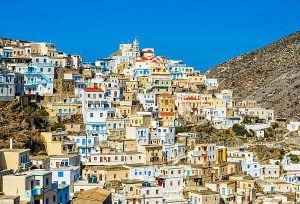
One of the largest and most diverse groups of islands in Greece, the Dodecanese offer the traveler a special view of the Greek summer. From the atmospheric Chora of Patmos and that of Astypalea to the rising neoclassical states of Symi, Agathonisi and Kastelorizo and from the vast beaches and archeological sites of Rhodes and Kos to the unspoiled landscapes of Karpathos and Nisyros, every visitor he can find the type of vacation that suits him.
Fans of the beach, lovers of luxury and nightlife and families usually choose the largest and most developed tourist islands, such as Rhodes. Couples, sophisticated and young groups looking for the different have made Symi, Tilos and Nissyros their hangout.

The hotel infrastructure follows the style of the holidays of each island: luxury resorts, spas and family hotels in Rhodes and Kos, atmospheric hostels in old houses in Kastelorizo, Symi or Astypalea.
Although the connections between them are not ideal for island hopping, there are many who choose to share their vacation on two or three different islands, usually combining one of the big ones with some smaller satellites, like Rhodes with Halki , Symi or Kastelorizo and Kos with Nisyros, Tilos or Lipsi.
What are the lasrgest of the Dodecanese islands ?
Rhodes is the capital of the archipelago – by far the biggest island in the group with good air and sea links to the other islands, Athens, Turkey, Cyprus and Israel. Rhodes and Kos both have international airports with regular charter flights to and from the UK and other European destinations. If you’re planning an island-hopping tour of the Dodecanese your best bet is to fly into one of the main islands then rely on ferries or hydrofoils to take you the rest of the way.
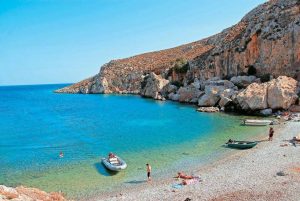
You’ll also find some of the liveliest nightlife in Europe – it’s been said that Rhodes has more bars and discos per person than New York, Paris or Berlin. And the frantic frolicking at the island’s top seaside resort of Faliraki has attracted international media attention on more than one occasion.
Kos, the second largest island in the group, can give Rhodes a run for its money when it comes to serious partying. Besides hardened revellers, the island also attracts hordes of visitors to the medical school and sanctuary built in the 4th century BC after the death of Hippocrates, the Father of Modern Medicine who was born on the island.
Attractions of the Dodecanese
The Dodecanese islands offer a wide range of experiences, from exploring ancient ruins and historical sites to enjoying beautiful beaches and engaging in outdoor activities. The islands’ rich cultural heritage, seen in their festivals, cuisine, and traditional crafts, adds depth to the travel experience. Whether seeking a relaxing beach holiday, a cultural exploration, or an adventure in nature, the Dodecanese islands cater to a variety of interests, making them a must-visit destination in the Aegean Sea.
One of the most prominent islands in the Dodecanese is Rhodes, known as the island of the Knights. Rhodes is famous for its medieval Old Town, a UNESCO World Heritage Site, with its well-preserved walls, the Palace of the Grand Master, and the Street of the Knights. The island’s diverse landscape includes lush green valleys, beautiful beaches, and ancient ruins, such as the Acropolis of Lindos, which offers amazing views of the surrounding area.
Kos, another major island in the Dodecanese, is celebrated for its rich history and association with Hippocrates, the father of medicine. The island is home to the ancient Asclepeion, a sanctuary dedicated to Asclepius, the god of medicine, and the Plane Tree of Hippocrates, where he is said to have taught his pupils. Kos also boasts beautiful beaches, vibrant nightlife, and charming villages like Zia, which offers panoramic views of the island.
Patmos, known as the “Island of the Apocalypse,” is a significant religious destination due to the Monastery of Saint John the Theologian and the Cave of the Apocalypse, where Saint John is believed to have written the Book of Revelation. The island’s serene atmosphere, beautiful beaches, and traditional architecture make it a peaceful retreat.
Karpathos, located between Crete and Rhodes, is distinguished by its rugged terrain, traditional villages, and pristine beaches. The village of Olympos is particularly notable for its well-preserved customs and colourful houses. Karpathos offers opportunities for hiking, windsurfing, and immersing oneself in local traditions.
The small island of Symi is famous for its neoclassical architecture, with colorful mansions lining its harbour. The island’s main attraction is the Panormitis Monastery, a site of pilgrimage, while its secluded beaches and tranquil bays offer a peaceful escape.
Astypalaia, often referred to as the “Butterfly of the Aegean” due to its shape, is known for its Venetian castle, traditional windmills, and beautiful beaches. The island’s unique charm lies in its blend of Cycladic and Dodecanese architectural styles.
Leros, with its rolling hills, tranquil bays, and historical significance, is a hidden gem. The island played a pivotal role during World War II, and remnants of this history can be seen in the War Museum and the impressive Castle of Leros.
Other islands like Nisyros, with its active volcano and traditional villages, and Kalymnos, famous for sponge diving and rock climbing, add to the diverse appeal of the Dodecanese. Each island has its own unique attractions, from the tranquil beaches of Lipsi and Tilos to the rich history of Kastellorizo and Halki.
Unspoiled Dodecanese islands
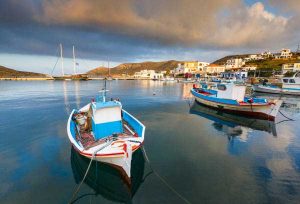
Kalymnos offers mountainous scenery interspersed with fertile valleys, some of the finest fresh fish tavernas in the Aegean and lovely unspoilt beaches, some of which can only be accessed by boat.
An increasing number of foreign travellers are starting to discover the many delights of Leros which boasts good beaches and tourist facilities whilst still retaining its essentially Greek character. But most package holidaymakers by-pass the small islands of Agathonisi , Symi, Lipsi and Tilos which appeal to hikers, nature lovers and those who simply want to relax on an uncrowded beach.
Local customes and Culture
The cultural identity of these islands is shaped by a blend of Greek, Byzantine, Ottoman, and Italian heritages, creating a distinctive and captivating ambiance.
One of the most prominent aspects of Dodecanese culture is its strong tradition of music and dance. These islands are known for their vibrant musical heritage, which includes traditional songs and dances passed down through generations. The music often features instruments like the lyra, a stringed instrument similar to a small fiddle, and the laouto, a type of lute. Dances such as the Sousta, Ballos, and Syrtos are popular, especially during local festivals and celebrations, where islanders don traditional costumes and perform for both locals and visitors.
Festivals and religious celebrations are central to the cultural life of the Dodecanese. Each island has its own calendar of events, often tied to the Orthodox Christian faith. Important religious feasts, such as Easter, are celebrated with great enthusiasm, involving church services, processions, and communal feasting. Many islands also celebrate the feast day of their patron saint with special ceremonies, music, dancing, and feasting. These events are not only religious in nature but also serve as social gatherings, strengthening community bonds.
The Dodecanese islands have a rich tradition of craftsmanship, with skills in pottery, weaving, embroidery, and woodcarving passed down through families. The island of Rhodes, for example, is famous for its decorative ceramic plates and tiles, while Karpathos and Patmos are known for their traditional weaving and embroidery. These handmade crafts are not only a source of income for local artisans but also a way of preserving the islands’ cultural heritage.
The architectural heritage of the Dodecanese is another reflection of their cultural richness. Influences from different eras and occupiers are visible in the islands’ buildings. Medieval castles, Byzantine churches, Ottoman mosques, and Italian-style buildings coexist, showcasing the historical layers of these islands.
Cuisine in the Dodecanese is a delightful blend of traditional Greek and Mediterranean flavors, with an emphasis on fresh, locally sourced ingredients. Seafood plays a significant role in the diet, along with olive oil, vegetables, and herbs. Each island has its own specialties, such as the sweet pastries of Kalymnos or the unique cheeses of Nisyros. The culinary traditions of these islands are a celebration of their natural bounty and a vital part of their cultural identity.
The Dodecanese islands are also characterized by their unique dialects and linguistic idiosyncrasies. The Greek language spoken here has been influenced by various occupiers and the islands’ proximity to Asia Minor, resulting in distinct accents and vocabulary.
Agathonisi
Agathonisi is a small Greek island situated in the northernmost part of the Dodecanese archipelago in the Aegean Sea. Known for its serene beauty and tranquil environment, the island is a hidden gem that offers a peaceful retreat from bustling tourist destinations.
The island covers an area of approximately 14.4 square kilometers and has a modest population of around 150 residents, contributing to its quiet and intimate atmosphere. The main settlements on the island are Megalo Chorio and Mikro Chorio, both of which exude traditional Greek charm with their white-washed houses and narrow streets.

Astypalea
The architecture and arid landscape of Astypalea are reminiscent of the Cyclades, but the map and the distance from Piraeus says Dodecanese. The postcard town with the beautiful Venetian castle defines the travel image of the island, which is a favorite summer destination for travelers with a sophisticated but also young profile – as it has camping sites and timeless night spots.
Spread between the bays of Pera Gialos (the old port) and Livadia, the capital gathers all eyes on it day and night, from the neck with the windmills and the haunts of the square to the Venetian castle of the Querini and the alleys that lead to the churches of Panagia Portaitissa and Megali Panagia.
The island is not particularly large and has a bus service as well as tourist boats, which serve your main routes to the resort of Maltezana and the beach fish taverns of Schinontas (both on the eastern side, after the natural strait that separates Astypalaia from Mesa and Exo Nissi) but also to the Livadi tourist settlement and the best beaches on the west side (at Vatses and Kaminakia you can reach them by tourist boats but also by car (by dirt road).
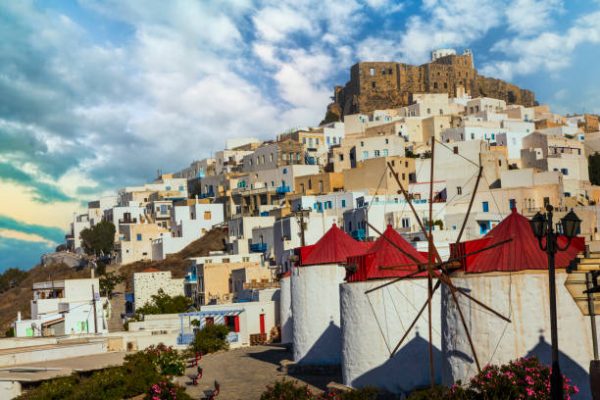
Kalymnos
In the Dodecanse, between Kos and Leros, on the island of sponges you will understand first hand what the proposition “low profile holidays at low cost” means. Its strong points are the beautiful beaches, the mountainous landscape, which offers you ideal climbing routes, the idyllic seabed, in which you will discover quite a few treasures – even impressive shipwrecks -, and the very hospitable residents.
The amphitheatrically built capital of Pothia, with the church of Agios Savvas at its left end and the chapel of the Resurrection at the right, will be your starting point. Walk through its picturesque narrow streets and observe the unique architectural buildings, which have been left to tell the stories of the Italian conquerors.
As for the rest of the settlements, there are Vathi with the beautiful fjord that forms the port of the Rina, Emporios (24 km. north of Pothia), which attracts water sports enthusiasts, and the secular Masouri and Panormos, which will monopolize your rides, while also providing you with valuable recommendations for accommodation and food. Finally, it is worth renting a boat or taking one of the liners for a day trip to the nearby islands of Telendos and Pserimos.
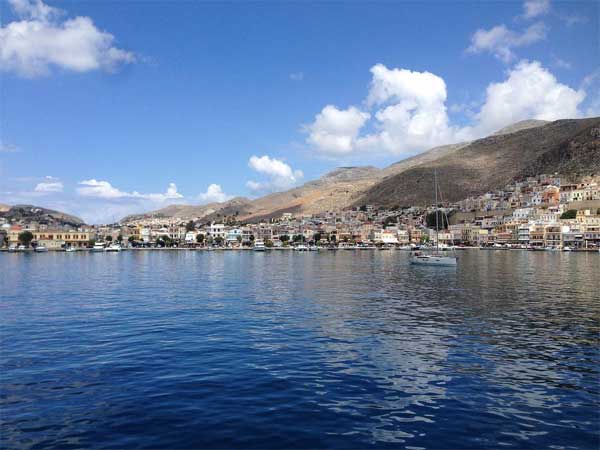
Karpathos
Karpathos is an alternative island in Greece, authentic with wild, virgin beauty, contrasts, changing landscapes, and beaches that will stay unforgettable. The fact that it preserves some traditional customs, especially in the villages, automatically makes it a unique destination.
Karpathos is an ideal destination for quiet holidays, exploration, and quite a bit of driving. Karpathos is the second largest island in the Dodecanese after Rhodes. If you like to spend all day at the same beach, then Karpathos is not a good choice.
Karpathos belongs to the islands of the so-called barren line, which means that it will take several hours to get there. However, the remote islands are those that do not have mass tourism and where you can enjoy more.
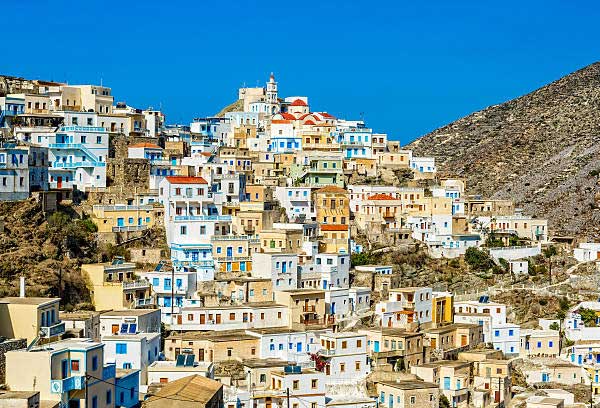
Kastelorizo
The easternmost point of Greece and the Dodecanese, is an island for few. It has no beaches, only deep and clear waters for diving. Megisti got the name Kastellorizo because of the red rocks of the hill where the Castle of the Knights is built, or Castello Rosso. Although it belongs to the barren line, it maintains something of the cosmopolitanism bequeathed to it by the Italians who “discovered” it in the 70s, bought houses here and come and come again.
Not without reason, since the whole settlement is preserved and the small, colorful neoclassical buildings that crown the natural harbor look like scenery, as they reflect on the transparent green waters. It is ideal for couples in love, for those looking for complete relaxation and for those who want to forget the sound of cars! The only road, moreover, connects the port (where the settlement is located) with the airport.
The plane is the best way to get here: there is a daily connection to Rhodes, but it is advisable to book early. At first it may seem impossible to spend more than two days on the island, but once you get into its rhythm the time passes very pleasantly.
With walks on the small pier, strolling with a view of the restored houses, with fish dishes in the few taverns and also short excursions. You can tour the island, which includes a swim in Ro and a visit and swim in the Blue Cave, or take a boat trip to Kas in Turkey to visit the sunken state of Kekova, Agios Nikolaos and the Lycian Tombs.
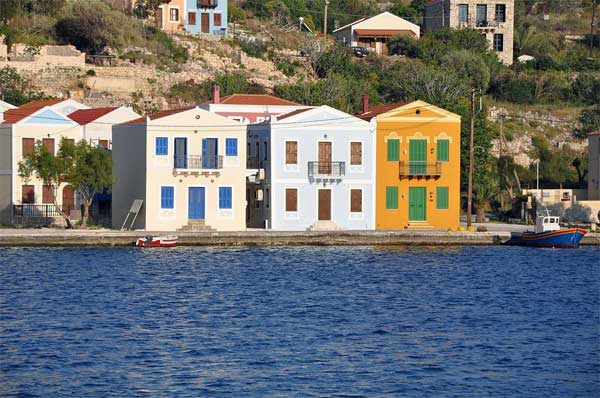
Kos
Kos one of the most visited island of the Dodecanes, with vast sandy beaches and visible ancient and… chivalric memories, the third largest island of the Dodecanese has not by chance emerged as one of the country’s international tourist flagships.
So, count on at least one week of stay here if you plan to indulge in an archeological and swimming safari. Naturally, the beaches have also defined the territory of the large hotel units in resorts such as Marmari, Mastichari, the family-run Tigaki and the favorite of the wild British youth, Kardamena.
Some of its most luxurious residential units are located in Psalidi, at a distance of 2.5 km south of the city. Be that as it may, however, you will put the charming capital in your plans to wander between building complexes with an aura of Italy but also chivalry as well as in archaeological sites, to drink a coffee in Eleftheria Square and in the port, while the in the evening, the youth meet at the mainstream bars in Exarchia and at the all day beach bars on the nearby beaches.
When it’s time to tour, visit the famous Asklepiion and the Hippocrates Botanic Garden studded with medicinal and aromatic plants of the Greek land, the great medieval castle of Antimachia, the Byzantine Old Gate and the traditional mountain village of Zia for dining with the whole island in your feet.
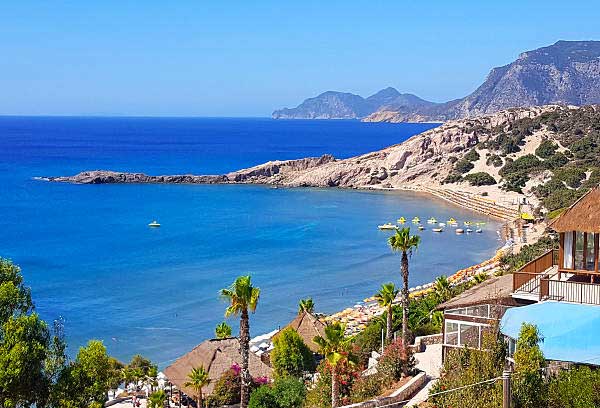
Leros
Leros island in the dodecanese in recent years it has been quietly rising, attracting mainly sophisticated foreign visitors and those looking for something different. Of special architectural interest are the Egyptian mansions of Agia Marina and the unique interwar architectural complex in Lakki in Europe.
Its center is Agia Marina, where most of the bars and restaurants are gathered along the waterfront and the main street. The main resort, a breath away from it, is Alinda, while Drymonas, Xirokambos and Panteli are small fishing villages where you will go mainly for the fish restaurants.
The beaches are not particularly numerous or impressive, but you will find quiet coves even in August, as well as shores to explore by boat. The island is small and you will easily discover its beautiful corners – as long as you have a car. A few, but satisfactory accommodation proposals, several low budget seafood options and some idiosyncratic restaurants with an Italian color make up the landscape of services offered.
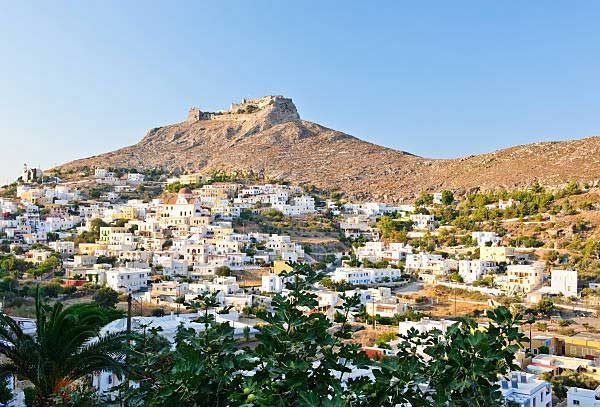
Nisyros
The volcano of Nisyros island in the Dodecanese, whose aura characterizes the entire island, the few but authentic villages and the wild volcanic beaches, the sophisticated, sophisticated tourists who stay the night after the daytime tourists from Kos have left are just a few of the characteristics of this island.
The port and capital Mandraki will immediately steal your heart with its cobbled streets, colorful flower-filled courtyards, cafe-bars in a row next to the sea and whitewashed houses – here, after all, you will find the island’s nightlife as well as more worthwhile accommodation suggestions. Its center is the bustling and archetypal island Square of the Elderly.
Its beach, Chochlakia, is full of black pebbles. In Nikia, with the beautiful central square with the chochlakia (pebble floor) and the now-ruined Emporio you will go for picturesque walks and the panoramic views of the volcano and Palos for ouzo next to the beach. Pachia Ammos is the most famous beach: black, volcanic, gathers free campers.
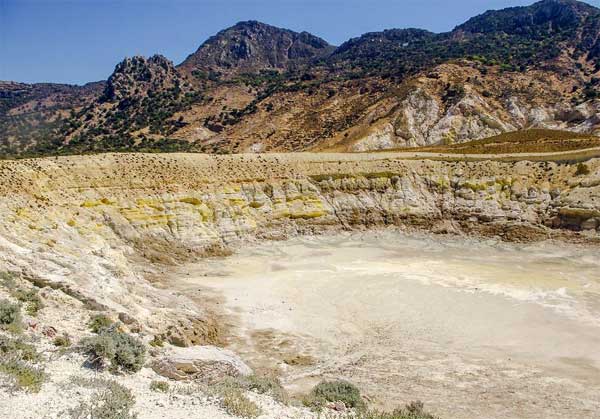
Patmos
Patmos is the sacred island of the Dodecanese has for years evolved into a cosmopolitan, sophisticated destination, while maintaining the mystical atmosphere. Greek and foreign (mainly Italian and French) visitors remain largely eclectic, low-key, with tendencies of inward search, but not isolation. The center of the island is the port of Skala, although the traditional white Chora with the evocative castle at the top is the most importent attraction.
Labyrinth narrows around the castle, clearings and small squares, well-preserved mansions, alleys with arches and arcades that lead to the edge of the rock giving a unique view, advanced clothes and accessories shops and chapels compose a dreamlike setting through a route without beginning and end. Even those who do not believe, do not fail to visit the two main attractions (and pilgrimages) of the island, the monastery of John the Theologian in Chora and the Cave of the Apocalypse.
As soon as you pass the gate of the castle, the atmosphere acquires another gravity, making the metaphysical dimension of the space felt. As for the beaches, the eastern and southern sides will not disappoint you at all. The boats will take you to Psili Ammos (the best on the island), while by car you will reach Diakofti, Agriolivadi, Lampi, Geranos, Groikos and Kampos.
Almost all of them have good taverns with fresh fish. Also set aside a day for a walk to the nearby islands: Lipsi, Arkoi and Agathonisi. The Easter celebrations are also particularly ritualistic: the most characteristic of the revived customs is the Ceremony of the Washbasin, the reenactment of the climax of the Last Supper, on the morning of Holy Thursday in the Town Hall Square.
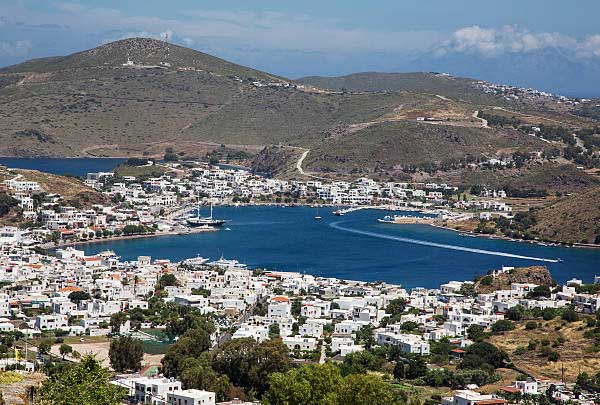
Rhodes
Rhodes island is one of the most well-preserved medieval cities in the world, dozens of impressive beaches, important archaeological sites, interesting hinterland and, of course, a highly developed hotel infrastructure and vibrant life make Rhodes an ideal island for getaways of a different style.
It is equally enjoyed by lovers of luxury resorts and family vacations, as well as by those who want to combine relaxation on the beaches either with monuments from different historical periods (from antiquity to the Italian occupation) or with intense nightlife and worldliness.
The medieval town will monopolize your walks with both the sights and the atmospheric restaurants and bars, while the most beautiful part of the new town is the beach promenade with the casino in the historic “Hotel of the Roses” and the rest of the buildings of the Italian occupation (National Theater, Governor’s Office, Post Office, etc.) but also the much-photographed beach.
At least one day is worth spending in the island’s second-largest city, Lindos, with its citadel and unique captain’s houses. The most popular accommodation bases are the seaside resorts close to the city (Ixia, Ialyssos, Kallithea, Faliraki), while in the south there are even less crowded beaches and “hidden” villages. It is an ideal island for those who love car trips and sightseeing: from the Valley of Butterflies and the Baths of Kallithea to the hill of Filerimos and Ancient Kamiro, the occasions for a walk are many and varied.
Of course, the most unknown hinterland with its many natural beauties and monuments of the Italian occupation also deserves your attention. The villages of Kolymbia (25 km from the city) and Archangelos (28 km from the city) are also of interest: the first for its greenery and pebbly beach and the second for the faith of the inhabitants in their traditions and linguistic idiom (strongly reminiscent of Cyprus). Finally, Rhodes can be combined with one-day trips to the surrounding satellite islands, such as Chalki and Symi.
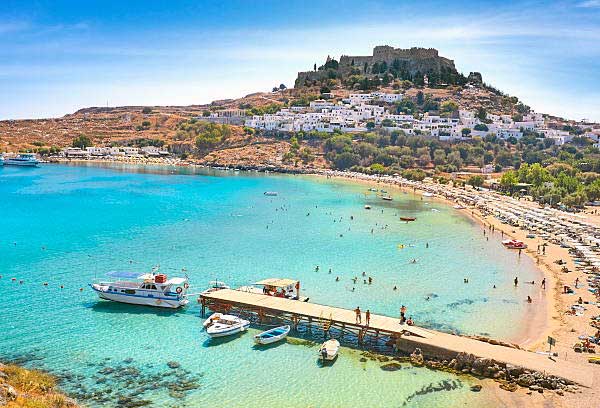
Symi
Symi one of the most impressive islands of the Dodecanese, thanks to the 2,500 colorful neoclassical buildings that stretch from Gialos (the port) to Chorio, creating a unique architectural ensemble. It is one of the first settlements in Greece to be classified as preserved, which is why it remains untouched.
From the 90s onwards, the island that was for years a hidden secret of the inquisitive English and the faithful who came from Rhodes to worship the monastery of Panormitis became fashionable for anxious Greek travelers as well, who fill it to the brim every summer – the active cultural festival also helped in this. It is loved by a sophisticated and cultured audience.
The fans of hiking will not be happy here, as the island is small and the road network is not particularly developed, while the beaches are usually reached by boat or water taxi. Accommodation options are mainly limited to boutique hotels, while renting old traditional houses is also a common practice. The center is Gialos, where you will find most restaurants and bars.
A registered trademark is the Clock of 1881 and the police building – an example of Italianate architecture. It is worth going up to the Village from the stone-paved Kali Strata with the 500 steps and enjoy wonderful views.
In the Village, look for the mansions of Hatziagapitou – Hatziioannou and Farmakidis, where the Archaeological-Folklore Museum is also housed, the Virgin of the Castle with the image of the Second Coming of the post-Byzantine hagiographer Georgios Klontzas, the ruins of the castle and the municipal clinic, where the objects are kept of the old pharmacy.
In addition to a walk to the picturesque seaside village of Pedi, it is also worth taking the route to Panormitis, through a cypress forest with many monasteries and churches.
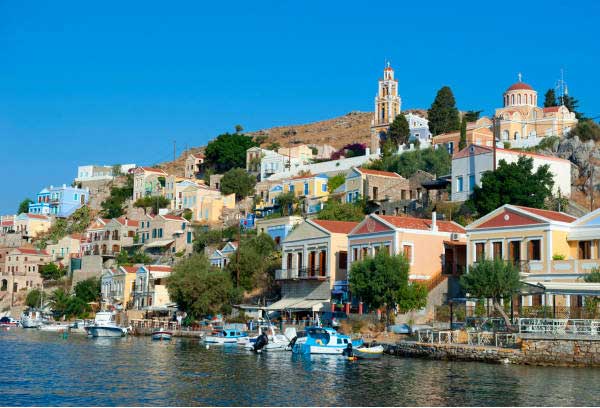
Tilos
A small island in the Dodecanese, between Nisyros and Chalki, Tilos finds its audience in the summer months with lovers of quiet holidays and free camping.
The campers seek coolness under the tamarisk trees on the popular sandy beach of Eristo and in the more remote Plaka, families and couples stay in rooms for rent mainly in the tourist port of Livadia and everyone writes routes on the one (and essentially only) asphalt road that unfolds along the backbone of the island, from the port to the monastery-eagle nest of Agios Panteleimon.
Leaving Livadia and after crossing a sheltered plain dotted with churches from the period between the 13th and 15th centuries, Megalo Chorio, the picturesque capital of the island below the castle, dominates the hillside. A detour through the valley with agricultural crops leads to Eristo.
But if you continue on the main road, you will reach the fishing village of Agios Antonios, Plaka beach and finally the monastery of the island’s patron saint. Special discoveries in the hinterland: the abandoned Mikro Chorio and the Harkadio cave, where fossilized bones of dwarf elephants were found.
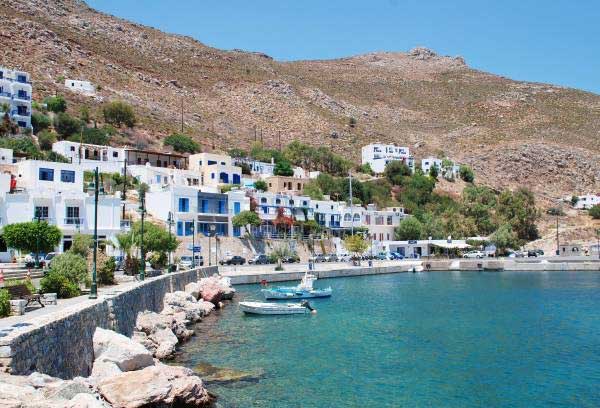
Halki
Halki is a small but beautiful island of the Dodecanese, located opposite the eastern coast of Rhodes, with which it has almost the same history.
Chalki – Dodecanese
The island got its name from the copper mines that operated there in the past. Halki has recently been declared the center of “Peace and Friendship” mainly among young people who visit the area in the summer and organize various cultural events.
Everywhere on the island there is a peaceful atmosphere and the buildings are examples of interesting architecture. The only settlement is Niborio or Iborio, built amphitheatrically at the south-eastern end of the island.
As soon as the visitor arrives at the port, he thinks he is looking at a well-designed painting. Scattered throughout are traditional, stone-built buildings and interesting monasteries with that of Agios Ioannis standing imposingly at the top of the hill.
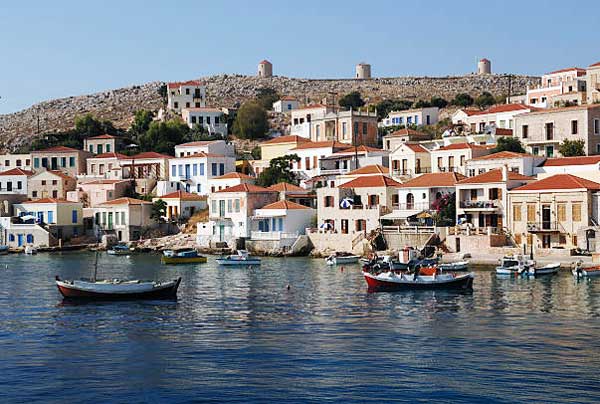
How to get to the Dodecanese islands
The Dodecanese are accessible both by air and by sea, offering travellers flexibility in planning their Greek island adventure.
Travel to Dodecanese by Air
The most convenient way to reach the Dodecanese islands is by air, especially for international travellers. The two main airports in the Dodecanese are located on the islands of Rhodes and Kos, with both airports serving a significant number of direct flights from various European cities, particularly during the summer tourist season. Airlines operate both scheduled and charter flights, connecting major European hubs to these islands.
For those traveling from cities without direct flights to Rhodes or Kos, another option is to fly to Athens and then take a domestic flight to one of the Dodecanese islands. Athens International Airport, being the largest in Greece, offers a wide range of domestic flights to various islands in the Dodecanese, including Rhodes, Kos, Karpathos, Leros, and Astypalea. These domestic flights are operated by Greek airlines such as Aegean Airlines, Olympic Air, and Sky Express, and typically take between 45 minutes to an hour.
By Ferry
Traveling to the Dodecanese by ferry offers a scenic and leisurely alternative to flying. Ferries to the Dodecanese depart from Piraeus, the main port of Athens, and connect to several islands in the archipelago, including Rhodes, Kos, Patmos, Leros, and Kalymnos. The journey by ferry can be quite long, ranging from roughly 7 hours to over 20 hours, depending on the destination and type of ferry service. High-speed ferries offer faster travel times but are generally more expensive than conventional ferries.
For those already in Greece or visiting other Greek islands, ferries also operate between the Dodecanese islands and other island groups, such as the Cyclades, the North Aegean islands, and Crete. This interconnected ferry system allows for flexible island hopping and the opportunity to explore multiple Greek islands during a single trip.
Travelers should be aware that ferry schedules can vary based on the season, with more frequent services in the summer months. It’s advisable to book ferry tickets in advance, especially for travel during peak season or on high-speed ferries. Onboard facilities typically include cabins, seating areas, restaurants, and shops, providing comfort during the journey.
